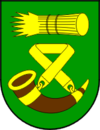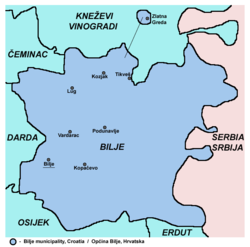Bilje
| Bilje | ||
|
||
|
|
||
| Basic data | ||
|---|---|---|
| State : |
|
|
| County : |
|
|
| Area : | 344 km² | |
| Residents : | 5,642 (2011) | |
| Population density : | 16 inhabitants per km² | |
| Telephone code : | (+385) 031 | |
| Postal code : | 31327 | |
| License plate : | BM | |
| Structure and administration (status: 2013, cf. ) |
||
| Community type : | local community | |
| Structure : | 8 districts | |
| Mayor : | Željko Cickaj ( HDSSB ) | |
| Website : | ||
The municipality of Bilje is located in northeastern Croatia . The seat of the municipality is Bilje. The main economic sectors are agriculture, tourism, fruit growing, viticulture, etc. The municipality consists of eight villages: Bilje, Kopačevo, Kozjak, Lug, Podunavlje, Tikveš, Vardarac, Zlatna Greda.
location
The municipality of Bilje is located in the south-western part of the Baranja, in the microregion of the Drava - Danube marshland . Bilje, the seat of the municipality, is a short distance (7 km) from Osijek (the seat of the Osijek-Baranja County ). The D7 road and the Ž4042 and Ž4056 county roads also pass through Bilje.
population
According to the last census in 2011, the municipality of Bilje had 5,642 inhabitants, who are divided into 8 villages as follows:
- Bilje - 3613
- Kopačevo - 559
- Kozjak - 60
- Lug - 764
- Podunavlje - 1
- Tikveš - 10
- Vardarac - 630
- Zlatna Greda 5
history
The villages of the municipality of Bilje were created on the confluence of the Drava and Danube flood areas. The flood areas were already populated in prehistoric times , as can be seen from extensive archaeological finds. Bilje, Kopačevo, Vardarac and Lug have been on important routes since Roman times, when the Limes ran through them on the way from Mursa Maior (Osijek) to Aquincum (Budim). During the construction of the Josip path (1772–1777) - the road wall connecting Osijek with Bilje - a milestone was found on the level crossing with the Roman path . At the time of the Turkish occupation, Lug was the focus of reform, with Mihajlo Starin playing an essential role. After the victory over the Turks at Senta (1667), Duke Eugen Savojski received almost all of Baranja from Emperor Leopold I (HRR) and thus built the hunting lodge in Bilje , which served as the administrative seat of the feudal lordship for several centuries . In addition, the important European agronomist and technologist Ljudevit Mitterpacher von Mitterburg comes from Bilje, whose works have further developed European agriculture and the technology of processing agricultural products.
Attractions
Kopački rit
Kopački rit is a nature park and is 3.5 kilometers from Bilje. There you can see all kinds of animals. Among other things, there are even 260 species of birds at home.
Steppe meadow
The only remains of the steppe meadow in Croatia are in the area of the municipality of Bilje . These were protected by the local community.
Culture
The largest churches in the municipality of Bilje are the “Crkva Bezgrešnog Začeća Blažene Djevice Marije” church in Bilje and the Calvinist church in Lug. In the villages you can still admire well-preserved houses and family farms with traditional architecture, which belong to the style of rural baroque , eclecticism and Secession . The activity of the folklore associations , which maintain the dances and customs, is also lively . The women make traditional handicrafts, valuable pieces of textiles and natural products . There are two country castles in Bilje and Tikveš. Eugen Savojski's baroque castle in Bilje is a zero-category monument. The Habsburg family's hunting lodge welcomed many kings and emperors, e. B. Franz Joseph , Wilhelm II. Etc.
Web links
References
- http://www.bilje.hr/
- http://www.tzo-bilje.hr/
- Leksikon naselja Hrvatske, Božidar Feldbauer


